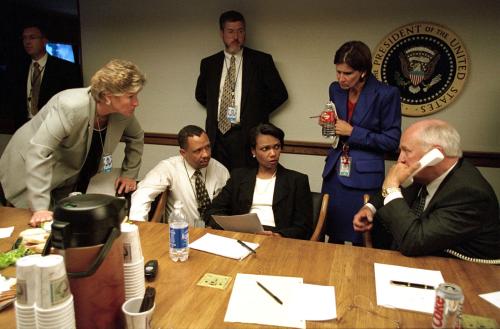 In the aftermath of 9/11 everyone, from elected officials and national security experts to ordinary citizens had one question: how could this happen to a nation with such an enormous and expensive military and intelligence architecture? The question was so ubiquitous that (in spite of some foot dragging by the Bush Administration) it eventually led to the creation of a high-level commission charged with seeking answers. Two and a half years after the attacks, in the summer of 2004, the Commission finished its work and released its report. The overriding conclusion was that the government’s principal failure in 9/11 was a failure to “connect the dots.” [1] What that meant was that pieces of the puzzle were to be found in many corners of the U.S. government but that no one connected the dots well enough or in a timely enough manner to predict with sufficient accuracy the attack that came.
In the aftermath of 9/11 everyone, from elected officials and national security experts to ordinary citizens had one question: how could this happen to a nation with such an enormous and expensive military and intelligence architecture? The question was so ubiquitous that (in spite of some foot dragging by the Bush Administration) it eventually led to the creation of a high-level commission charged with seeking answers. Two and a half years after the attacks, in the summer of 2004, the Commission finished its work and released its report. The overriding conclusion was that the government’s principal failure in 9/11 was a failure to “connect the dots.” [1] What that meant was that pieces of the puzzle were to be found in many corners of the U.S. government but that no one connected the dots well enough or in a timely enough manner to predict with sufficient accuracy the attack that came.
“The overriding conclusion was that the government’s principal failure in 9/11 was a failure to ‘connect the dots.’”
The report listed in depth the many failures that prevented the government from seeing what was coming. They cut a swath across the vast United States government. The State Department was in charge of visas but failed to catch the fact that several of the visas and passports of the hi-jackers were manipulated in a fraudulent manner. The FBI had the responsibility of keeping track of bad guys inside the United States while the CIA had the responsibility of keeping track of bad guys outside the United States. So two of the terrorists were tracked as they moved internationally (Nawaf al-Hazmi and Khalid al-Mihdhar) but tracking responsibility was not handed over to the FBI once they landed in the United States. Even when they were tracked and arrested, as when Zacarias Moussaoui was, he was charged with immigration violations. However, what brought him to the attention of the FBI—taking flight lessons for the purpose of using an airplane for an attack (he had no interest in learning to land the plane)—was not passed up the chain of command and not linked to the possibility of a broader plot. The Navy had its own intelligence system. And information that linked the attacks on the Navy ship the Cole to one of the 9/11 hi-jackers and to Al-Queda was missed. The FAA was in charge of airline security as well as security at airports. And yet no-fly lists were not updated with the names of terrorists, passengers identified by the airlines’ own system were not checked and aircraft cockpit doors were not hardened.
In the lead up to 9/11, the government was collecting vast amounts of data but failing to make sense out of it. Every day the U.S. government was collecting vast amounts of information via its satellites. And yet there were years of conversations waiting to be translated and years of photographs waiting to be looked at. Eight years after 9/11 the problem persisted—including huge backlogs and a shortage of translators.
There were other failures as well. The entire intelligence community was built to follow the Soviet monolith and it was moving at a glacial speed to try and adapt to the new threats posed by asymmetric warfare. For instance, it was laden with Russian speakers and disastrously short of Arabic speakers. According to one former intelligence community officer, speaking a few years after the attack, “…to a certain extent, the Soviet Union is still alive and well in the cultures and in the bureaucratic authorities of the IC.”
Finally, the 9/11 attacks signaled a change in the very nature of terrorism. Instead of being linked to concrete political goals, the new Islamic version welcomed mass casualties and did not shy away from killing non-combatants. Gina Bennett, a young state department analyst was one of the first American intelligence professionals to describe Osama bin Laden and his world view and she admitted that what she was describing “… wasn’t considered ‘normal’ in the world of counterterrorism.”[2]
“In the aftermath of 9/11 pressure built for change and policy makers started creating new organizations.”
In the aftermath of 9/11 pressure built for change and policy makers started creating new organizations. In November 2001, Congress created the Transportation Security Agency which federalized airport security which had been largely in the hands of private contractors to the airlines. In late 2002, Congress passed the Homeland Security Act which combined 22 organizations into the first new Cabinet Department since 1989. A combination of factors—the failure to find weapons of mass destruction in Iraq, criticisms raised during the 2004 presidential campaign and intense pro-reform lobbying by the families of victims of 9/11—resulted in passage of the Intelligence and Reform and Terrorism Prevention Act of 2004. The legislation created a new office, the Office of the Director of National Intelligence (ODNI) which was to “coordinate” the FBI, the CIA and the 14 other agencies that made up the U.S. intelligence community. And it established the National Counterterrorism Center to analyze and integrate all intelligence and threats to Americans at home and abroad. The law was an attempt to make the boundaries between domestic and international intelligence that had contributed to the nation’s inability to disrupt the 9/11 attacks more porous. But it also raised concerns about privacy and civil liberties. Thus, the law also created the Privacy and Civil Liberties Oversight Board.
The early organizational changes struck many as orthogonal to the real problems—like moving the deck chairs on the Titanic. The Department of Homeland Security (DHS) in particular, had severe growing pains—becoming at times a dumping ground for political appointees. But the organizational changes suffused the government with the ethos of sharing information that could lead to attacks. National Defense became a truly national function, shared by the cop on the beat as well as by the spy in the souk. DHS and the FBI created information sharing organizations in cities and states.
For much of this time and until his death in 2011, bin Laden dreamed of repeating his 9/11 attacks with another mass casualty attack on the West—as recounted by Peter Bergen in his new book, The Rise and Fall of Osama bin Laden. Attacks were foiled and home-grown terrorists caught and jailed. Even though the ODNI and DHS and the proliferation of counter terrorism centers sounded like a lot of bureaucratic mumbo-jumbo—the front lines of American security were transformed. More intelligence was shared and training was altered. The border patrol agent, the state department visa specialist, the flight attendant, and the general public (“See something, Say something”) were all on the lookout for trouble.
Intelligence failures still happen, despite protestations to the contrary. It looks like the failure to predict the rapid fall of Kabul, Afghanistan is just the latest. But the U.S. homeland is no longer dependent on one intelligence body. The multi-layered system of government has served us well over the past twenty years, let’s hope it continues.
[1] The 9/11 Commission Report: Final Report of the National Commission on Terrorist Attacks Upon the United States, New York, Norton, 2004, p. 408.
[2] Bergen, Peter, The Rise and Fall of Osama bin Laden, New York, Simon and Schuster, 2021, p. 103.






Commentary
9/11 and the reinvention of the US intelligence community
August 27, 2021